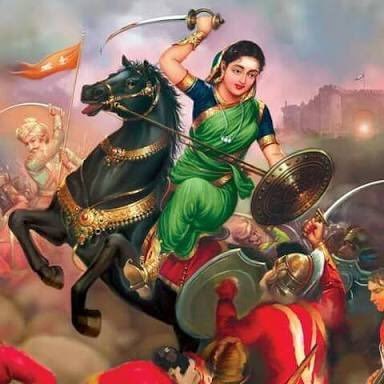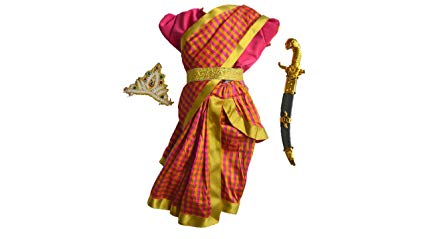Let’s look into the story of a lady warrior who was in an era even before the brave Jhansi Rani Lakshmi Bai. A warrior who was brave and immortal, yet the history overlooked her heroic deeds against the British. Kittur Chennamma can be definitely called the first female freedom fighter of India. Even though she could not win the battle against the British she definitely could create a revolution and turn into an inspiration to the women of the future generation.
Early Life of Kittur Chennamma: First Freedom Fighter of India
Chennamma was born on 23rd of October, 1778 to a Lingayat family in a small village called Kakati in the Belgaum district of present Karnataka. Chennamma was trained in sword fighting, archery and horse riding at a very young age. She was well known throughout the village for her bravery. At the age of 15, she was married off to Raja Malasaraja who belonged to the famous Desai family and were the rulers of the kingdom of Kittur which is presently situated in Karnataka. Thus she got the title of queen hence she is called Kittur Rani Chennamma.
Kittur Chennamma had to fight destiny even before her fight against the British since her husband died in 1816 leaving her with her only son. Soon Kittur Chennamma was struck with another tragedy as her only son also passed away in 1824. Struck by the cruelty of fate all Chennamma had was her beloved kingdom of Kittur and her loyal subjects.
Kittur Chennamma’s Life Turning Point
Rani Kittur Chennamma had to adopt Shivalingappa as the heir to the throne due to her son’s death. The British were irked with the adoption since Lord Dalhousie had introduced Doctrine of Lapse according to which if a king dies childless then the kingdom would lapse to the rule of East India Company and not to the adopted heir. St. John Thackeray held the in charge of administration for the province of Dharwad and then the kingdom of Kittur fell under the Dharwad province. Hence Rani Chennamma was notified about the doctrine and asked to accept to fall under the rule of East India Company to let go of her throne.
There was a strict warning against handing over the rule to Shivalingappa, the adopted heir. She was not ready to succumb to the pressure laid out by the British, hence she wrote a letter to Elphinstone, who was the lieutenant-governor of Bombay presidency, explaining her situation but the request was turned down blindly. She was a woman of iron heart and she was not ready to let go of her kingdom to the ruthless rule of the East India Company. She was ready to stake the claim for what belonged to her and the only way she could do that was to fight for her kingdom.
The British underestimated the power of this valiant queen and sent their forces to loot the valuables and treasures of the Kittur kingdom which then added up to 15lakh rupees. A British troop of around 20000men and 400 guns were sent to the Kittur kingdom from their Madras Artillery on October 1824. But the British were forced to kneel in front of the queen and her army since they had a major humiliating loss in the battle. They also lost their Collector St. John Thackeray in the war. All the credits of winning the war go to the shrewd and valiant Amatur Balappa a lieutenant in Rani Chennamma’s army.

This war also led to the imprisonment of 2 British officers, Walter Elliot and Stevenson. They were held as hostages and they were released only with a mutual agreement between Chaplin, the then commissioner, and Kittur Chennamma that the war would be halted and the Kittur kingdom would be left under peace with the rule and wishes of the queen.
But the British like many other times stooped down low, broke their promise and continued the war in a treacherous way. Rani Chennamma fought valiantly in the battle against British with the help of her trusted army general Krantiveera Sangolli Rayanna until she was captured and imprisoned at the Bailuhongala Fort where she took her last breath on February 1829.
The fight continued even after Kittur Chennamma was captured. Her loyal army led by her trusted General Sangolli Rayanna, brought as many losses as he could to the British by doing India’s first guerilla warfare against the British, also by disrupting all the meetings and events led by the British. Sangolli Rayanna wanted to make Rani Chennamma’s dream of installing Shivalingappa as the heir to the throne of Kittur come true and he fought till his last breath to make it a reality. However, the brave hero was killed treacherously by the British and Shivalingappa was arrested.
Legacy
Rani Chennamma without a doubt is the first female freedom fighter of India who turned into an inspiration to the women who followed her path. Even though she was the first freedom fighter somewhere over the history her name was shadowed just like many other great leaders who were deprived of the fame and respect they deserved.
Folklore is one of the ways we Indians can Know about and cherish the heroes like Kittur Chennamma. Like many other leaders, even Kittur Chennamma’s heroic deeds and valiant efforts are being sung even today in many ways in the form of ballads, Lavani and Gigi pada.
A movie was released in Kannada under the name Kittur Chennamma in 1961 directed and produced by B. R. Panthulu based on the story of Rani Chennamma. It starred the veteran actress B. Saroja Devi as Kittur Chennamma. There was also a reference of Rani Chennamma in the recent movie Krantiveera Sangolli Rayanna starring actor Darshan where the role of the valiant queen was portrayed by the famous actress Jayapradha.
A train connecting Bangalore to Kolhapur is named Rani Chennamma Express after the brave queen of Kittur. There is also a University called Rani Chennamma University located in Belagavi which was named in her honor.

The first female president of India unveiled the statue of the brave queen Kittur Rani Chennamma who paved way for other Indian women to fight for their freedom at par with men, at the Parliamentary Building premises at New Delhi on 11th September 2007. It is a tribute that is much deserving to the queen who was brave to fight against the Britsh and make them fear her.
As she lives on
The biggest tribute one can give to such heroes is being more aware of them. As the days go by let us look into the history and dig out the names of the Heroes whose heroic deeds went unsung. Our Independence was never a single person’s effort. It was a group effort with tears and bloodshed from all over India.
Every nook and corner of India must have had a hero who stood up against the atrocities of the British, who questioned the wrong of British. It is the collective effort of those Heroes that we are relishing today. This is an ode to the first female freedom fighter of India- Kittur Chennamma. Let this be an inspiration for the rise of many Chennammas of the present generation who will always stand against the wrong and choose the right path of virtue, honor, and bravery.
In this era where we still fight for the voice of women, we need to find our inspiration and spirit from women in older times, when they did what many men also feared. In a time where women had to hide behind their veils and where her voice must always be meek so she shouldn’t be heard, there were warriors who chose swords instead of flowers.














Very inspiring. Plz write more on our brave freedom fighters.
Love to read & hear about Veera Rani Kitturu Chennamma & Veera Yodha Sangolli Rayanna. Thanks.
Thank you ^_^
Sreeranjini Krishnan, thank you for this post. Its very inspiring.